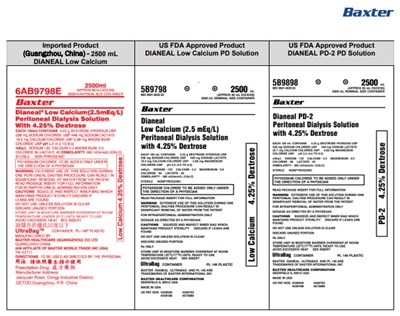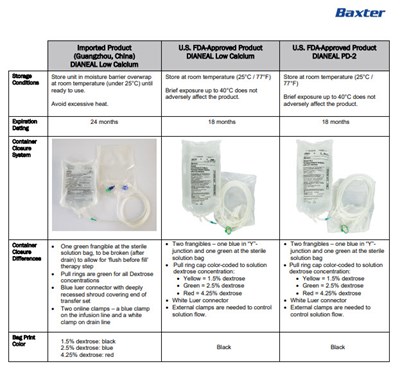Product Images Dianeal Low Calcium With Dextrose
View Photos of Packaging, Labels & Appearance
- Dianeal DHCP Letter 1 - image 01
- Dianeal DHCP Letter 2 - image 02
- Dianeal DHCP Letter 3 - image 03
- Dianeal DHCP Letter 4 - image 04
- Dianeal DHCP Letter 5 - image 05
- Dianeal DHCP Letter 6 - image 06
- Dianeal DHCP Letter 7 - image 07
- Dianeal DHCP Letter 8 - image 08
- Representative Dianeal Container Label - image 09
- Representative Dianeal Carton Label - image 10
- Representative Dianeal Container Label - image 11
- Representative Dianeal Carton Label - image 12
- Representative Dianeal Container Label - image 13
- Representative Dianeal Carton Label - image 14
Product Label Images
The following 14 images provide visual information about the product associated with Dianeal Low Calcium With Dextrose NDC 0941-0692 by Vantive Us Healthcare Llc, such as packaging, labeling, and the appearance of the drug itself. This resource could be helpful for medical professionals, pharmacists, and patients seeking to verify medication information and ensure they have the correct product.
Dianeal DHCP Letter 1 - image 01

This document provides important prescribing information regarding the temporary importation of DIANEAL Low Calcium (2.5 mEq/L) Peritoneal Dialysis Solution with Dextrose from China for use in Continuous Ambulatory Peritoneal Dialysis to address drug shortages. Baxter Healthcare Corporation is coordinating with the U.S. Food and Drug Administration (FDA) for this importation, and it is noted that the FDA has not approved this product manufactured by Baxter's facility in Guangzhou, China. The document also mentions the temporary period during which Baxter will offer the imported products from China, highlighting the differences in calcium content compared to other DIANEAL solutions. Patients receiving the China-imported DIANEAL solution are advised to have their serum calcium levels monitored for the development of hypocalcemia.*
Dianeal DHCP Letter 2 - image 02

This text provides detailed information about DIANEAL Peritoneal Dialysis Solutions, including differences between U.S.-manufactured and China-manufactured products, prescribing guidelines, packaging details, and instructions for reporting adverse events. It explains that the clinical practice for using the China-imported product is the same as with the U.S.-manufactured product and describes specific differences in product components, labeling, and connectors. Healthcare providers are advised to be aware of these variances and follow alternative procedures to ensure accuracy in product usage. The text also includes contact information for reporting adverse events related to the imported products.*
Dianeal DHCP Letter 3 - image 03

This is a contact information message from Baxter Healthcare Corporation regarding product quality issues and ordering information for DIANEAL Peritoneal Dialysis Solution. It includes details to report product quality issues, access FDA prescribing information, and reach out to Baxter's Medical Information Service. For orders, it provides the contact information for Baxter's Center for Home Care Services. The message is signed by Geovana Basso, MD, Director of Americas Medical Affairs.*
Dianeal DHCP Letter 4 - image 04

This text provides a detailed comparison between two peritoneal dialysis solutions, DIANEAL Low Calcium and DIANEAL PD2, including differences in composition, packaging, and FDA approval status. Key points such as calcium, magnesium, sodium levels, and container type are highlighted. It also outlines dosage instructions and ingredient specifications for each solution. In addition, it mentions storage conditions and regulatory compliance information. This comparison is beneficial for healthcare professionals and patients considering peritoneal dialysis therapy.*
Dianeal DHCP Letter 6 - image 06

The text provided is a comparison between DIANEAL PD Solution Container Labels for CAPD. It compares labels for different fill volumes (1500 mL, 2000 mL, 2500 mL, and 3000 mL) for import purposes. The labels for the US-approved products vary only in terms of product code, NDC, fill volume, and barcode, with no differences in composition or safety-related information. The comparison includes details for the DIANEAL Low Calcium PD Solution and DIANEAL PD-2 PD Solution. It also mentions the concentration of low calcium in one of the solutions (2.5 mEq/l).*
Dianeal DHCP Letter 8 - image 08

This is information about Baxter's DIANEAL products, specifically the Low Calcium PD Solution and the PD-2 PD Solution, both of which are approved by the US FDA. The Low Calcium PD Solution has a low calcium content (2.5mEq/L) and the PD-2 PD Solution contains 4.25% Dextrose. These solutions are intended for Peritoneal Dialysis.*
Representative Dianeal Container Label - image 09

This is a description of Baxter Dianeal® Low Calcium Peritoneal Dialysis Solution containing 1.5% Dextrose. Each 100mL of the solution comprises 1.5g Dextrose Hydrous, 538mg Sodium Chloride USP, 448mg Sodium Lactate, 18.3mg Calcium Chloride USP, and 508mg Magnesium Chloride USP among others. The solution has an osmolarity of 344 mOsmol/L and is sterile and non-pyrogenic. It is recommended for intraperitoneal administration only and should be handled carefully as per the instructions provided on the package insert. The product should be stored at room temperature until ready to use and should not be used if the solution is not clear. Potassium Chloride should be added under the direction of a physician.*
Representative Dianeal Carton Label - image 10

This is a description for a medical product: "LOW CALCIUM WITH 1.5% DEXTROSE ULTRABAG 2500mlX4. This product comes in a lot with an expiry date of January 2000."*
Representative Dianeal Container Label - image 11

This text is a detailed description of a medical solution intended for peritoneal dialysis. It contains information about the composition, instructions for use, storage recommendations, and cautions to be aware of when administering the solution. The solution is designed for intraperitoneal administration and contains a specific amount of dextrose, sodium chloride, calcium chloride, magnesium chloride, and sodium lactate. Additionally, it mentions that potassium chloride should only be added under the guidance of a physician. The product is to be stored in a moisture barrier overwrap at room temperature until ready for use.*
Representative Dianeal Carton Label - image 12

This is a product description for an IV solution of low calcium with 2.5% dextrose in an Ultrabag format. Each package contains 2500ml x 4 units with Lot G00000000 and expiry date in January 2000. The product code is IN0000.*
Representative Dianeal Container Label - image 13

This is a description of a 2500ml Baxter Dianeal® Peritoneal Dialysis Solution with 4.25% Dextrose and low calcium content. The solution includes dextrose, sodium chloride, sodium lactate, calcium chloride, and magnesium chloride. It is sterile and non-pyrogenic and should only have potassium chloride added under a physician's direction. Extensive use may remove significant water from the patient. The package insert should be read for complete information. The solution is for intraperitoneal administration only. It is advised to inspect the inner bag for leaks before use, and to discard if any are found. The solution should be clear before use, and any unused portion should be discarded. It should be stored in a moisture barrier overwrap at room temperature until ready for use. The manufacturer is Baxter Healthcare (Guangzhou) Co. Ltd in Guangzhou, China.*
Representative Dianeal Carton Label - image 14

This text appears to describe a medical product or solution. It is a low-calcium solution with 4.25% dextrose, packaged in Ultrabag with a volume of 2500ml. The lot number is possibly "G00000000" with an expiration date of January 2000.*
* The product label images have been analyzed using a combination of traditional computing and machine learning techniques. It should be noted that the descriptions provided may not be entirely accurate as they are experimental in nature. Use the information in this page at your own discretion and risk.

